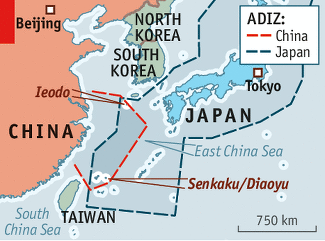

By The Economist
The announcement by a Chinese military spokesman on November 23rd sounded bureaucratic: any aircraft flying through the newly designated Air Defence Identification Zone (ADIZ) in the East China Sea must notify Chinese authorities in advance and follow instructions from its air-traffic controllers. America’s response was rapid. On November 26th Barack Obama sent two B-52 bombers to fly through the new zone without notifying China (see article). This face-off marks the most worrying strategic escalation between the two countries since 1996, when China’s then president, Jiang Zemin, ordered a number of exclusion zones for missile tests in the Taiwan Strait, leading America to send two aircraft-carriers there.
Plenty of countries establish zones in which they require aircraft to identify themselves, but they tend not to be over other countries’ territory. The Chinese ADIZ overlaps with Japan’s own air-defence zone (see map). It also includes some specks of rock that Japan administers and calls the Senkaku islands (and which China claims and calls the Diaoyus), as well as a South Korean reef, known as Ieodo. The move is clearly designed to bolster China’s claims (see article). On November 28th Japan and South Korea sent aircraft into the zone.
Related Reading:
